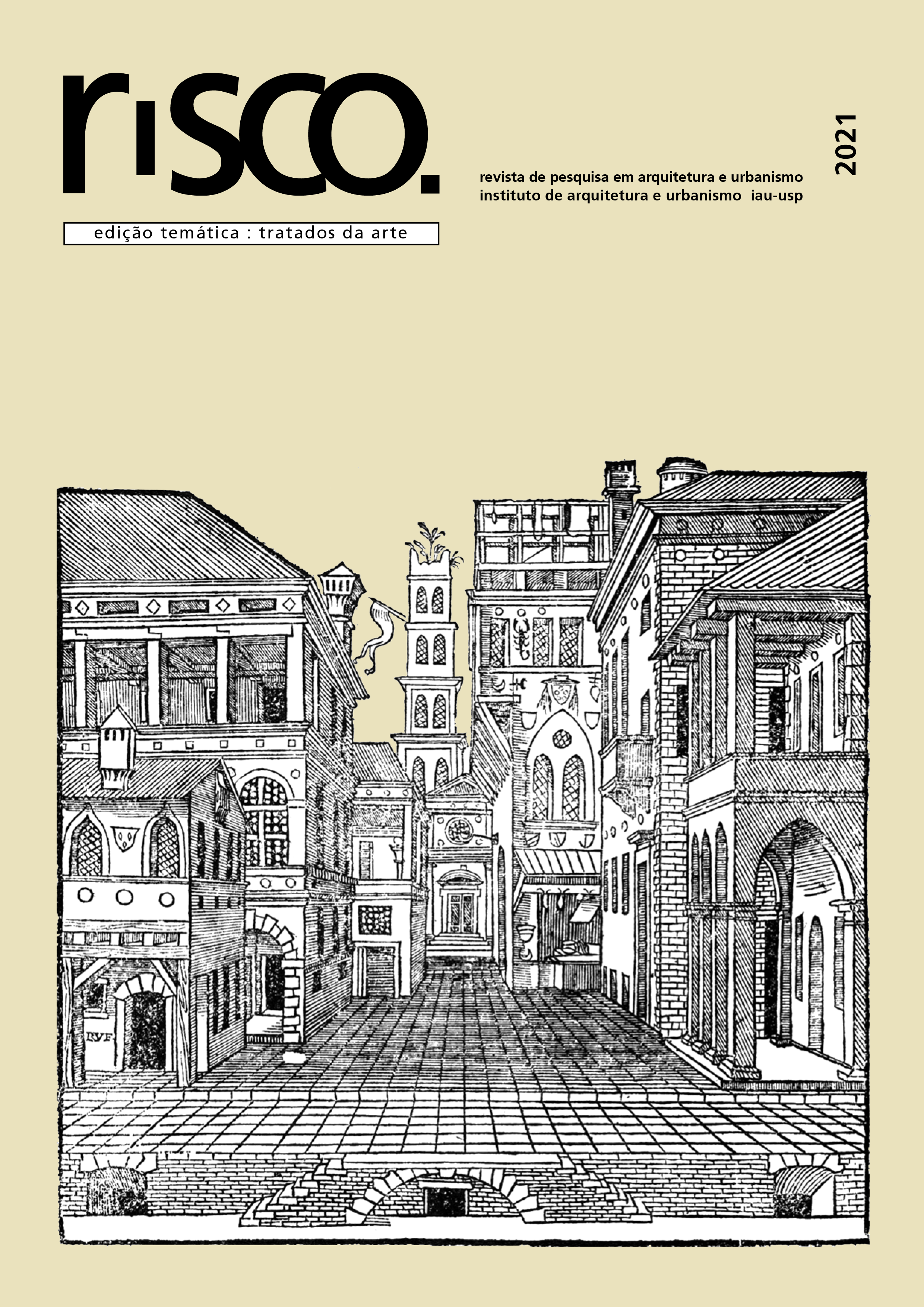From drawing and painting to the colorful flames in the scene – Plínio, Alberti and Serlio: ornato and amplification of the discourse on architecture, based on the qualifications Dei lumi artificiali delle scene
DOI:
https://doi.org/10.11606/1984-4506.risco.2021.166354Keywords:
Architecture, Scenography, Scenic lightingAbstract
This article aims to discuss the text Dei lumi artificiali delle scene, composed in the italian sixteenth century, literary work of the preceptor, Sebastiano Serlio, which deals of subjects related to architecture from the painter’s proposition. In the distinction of the arts, the prescription of the lume for the disegno visivo will follow the precepts of the treaty Da Pintura from Alberti. In the growing of the rhetorical construction, this proposition is supplanted when it comes to the lumi of the scena, that is, “lights that can be seen”,obtained by fire, that fall on colored paints, as shapes of material ornaments, amplify the relief and gi ve to se e volumes surpassing, by emulation, the natural things themselves
Downloads
References
ALBERTI, Leon Battista. De re aedificatoria. Texto latino e tradução de Giovanni Orlandi. Introdução e notas de Paolo Portoghese. Milano: Il Polifilo, 1966.
ALBERTI, Leon Battista. Da Pintura. Tradução de Antonio da Silveira Mendonça. 2. ed. Campinas: Edunicamp, 1992.
ARISTÓTELES. Arte retórica e arte poética. Tradução Antonio Pinto de Carvalho. Rio de Janeiro: Ediouro, [2005].
CERRI, Vânia Cristina. Tradução comentada de Trattato sopra le scene de Sebastiano Serlio. 2003. Dissertação (Mestrado em Filosofia) – Faculdade de Filosofia, Letras e Ciências Humanas, Universidade de São Paulo, São Paulo, 2003.
CERRI, Vânia Cristin. Os Aparelhadores de cenas e a preceituação da prática cênica: uma reflexão sobre a obra de Sebastiano Serlio. 2003. Tese de Doutorado em Arquitetura - Faculdade de Arquitetura e Urbanismo da Universidade de São Paulo, São Paulo, 2011.
CERRI, Vânia Cristin. Scaenae Frons – O Renascimento e as origens da cenografia moderna. São Paulo: Annablume, 2017.
FURLAN, Francesco. Per un ritratto dell’Alberti. In: Estratto da: Société Internationale Leon Battista Alberti. Albertiana Revue reconnue par le Centre Nationale de la Recherche Scientifique. Firenze: Leo S. Olschki Editore, 2011, v. XIV, p. 43 a 54.
HORÁCIO. Arte poética. Introdução, tradução e comentários de R. M. Rosado Fernandes. Lisboa: Inquérito, 1984.
KLEIN, Robert. Magia e Arte. A forma e o inteligível: escritos sobre o Renascimento e a arte moderna. In: ______. A forma e o inteligível. Artigos e ensaios reunidos e apresentados por André Chastel. Tradução Cely Arena. Revisão técnica Leon Kossovitch e Elisa Kossovitch. São Paulo: Edusp, 1998. São Paulo: Edusp, p. 149.
KLEIN, Robert; ZERNER, Henri. Vitrúvio e o teatro do Renascimento italiano. In: KLEIN, Robert. A forma e o inteligível: escritos sobre o Renascimento e a arte moderna. São Paulo: Edusp, 1998.
LICHTENSTEIN, Jacqueline. A cor eloqüente. Tradução de Maria Elizabeth Chaves de Mello e Maria Helena de Mello Rouanet. São Paulo: Siciliano, 1994.
PLINE, L’ANCIEN. Histoire naturelle (livre XXXV). Texte établi, traduit et commenté par J. M. Croisille. Paris: Les Belles Lettres, 1985.
PLINE, L’ANCIEN. Histoire naturelle (livre XXXVI). Trad. R. Bloch. Paris: Les Belles Lettres, 1981.
PLINE, L’ANCIEN. Histoire naturelle (livre XXXVII). Trad. E. Saint-Denis. Paris: Les Belles Lettres,1972.
SERLIO, Sebastiano. Tutte l’Opere d’Architettura et Prospetiva di Sebastiano Serlio. Venetia: Giacomo de Franceschi, 1619. New Jersey: The Gregg, 1964 (Fac-símile).
SHEARMAN, John. O maneirismo. Tradução O. Mendes Cajado. São Paulo: Cultrix, 1978.
TRIMPI, Wesley. Horace’s ut pictura poesis: the argument for stylistic decorum. The Early Metaphorical uses of skiagraphia and skenographia. Traditio: Studies in Ancient and Medieval History, Thought and Religion: publicação da Fordham University Press, New York, v. XXXIV, 1978. p. 403-413.
Downloads
Published
Issue
Section
License
Copyright (c) 2021 Vania Cristina Cerri

This work is licensed under a Creative Commons Attribution-NonCommercial-ShareAlike 4.0 International License.
Autores que publicam nesta revista concordam com os seguintes termos:
a. Autores mantém os direitos autorais e concedem à revista o direito de primeira publicação, com o trabalho simultaneamente licenciado sob a Licença Creative Commons Attribution BY-NC-SA que permite o compartilhamento do trabalho com reconhecimento da autoria e publicação inicial nesta revista.
b. Autores têm autorização para assumir contratos adicionais separadamente, para distribuição não-exclusiva da versão do trabalho publicada nesta revista (ex.: publicar em repositório institucional ou como capítulo de livro), com reconhecimento de autoria e publicação inicial nesta revista.
c. Autores têm permissão e são estimulados a publicar e distribuir seu trabalho online (ex.: em repositórios institucionais ou na sua página pessoal) a qualquer ponto antes ou durante o processo editorial, já que isso pode gerar alterações produtivas, bem como aumentar o impacto e a citação do trabalho publicado (Veja O Efeito do Acesso Livre).

















